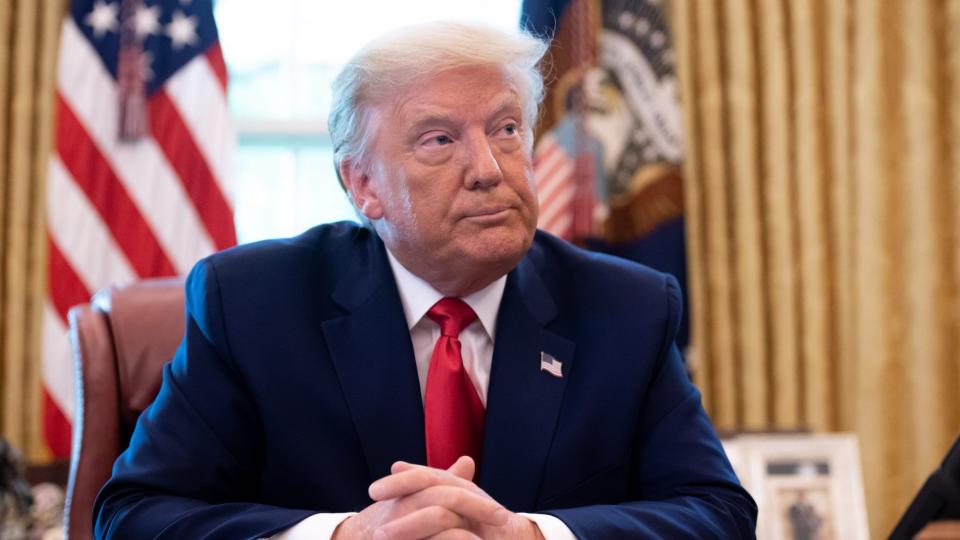What We Know About Donald Trump's Coronavirus Diagnosis

UPDATED: 10/5/2020, 2:52 P.M.
After announcing he and wife Melania Trump tested positive for coronavirus late Thursday evening, President Trump was transported to Walter Reed Medical Center the next day. His administration assured the public that the move was "out of an abundance of caution," and he would return to quarantine with the First Lady at the White House in a few days.
While Trump's team has maintained an optimistic outlook on his condition, contradicting reports have emerged about his health, and to make matters all the more confusing, the president has been actively tweeting from his hospital bed as if nothing is happening.

For a timeline of events indicating everything we know so far about Trump's coronavirus diagnosis, scroll below.
Trump is reportedly leaving the hospital on Monday evening.
Donald Trump tweeted on Monday afternoon that he will be leaving Walter Reed Medical Center at 6:30 P.M. after checking in on Friday. "Feeling really good!" he said, downplaying the true severity of the virus by telling followers, "Don't be afraid of Covid. Don't let it dominate your life. We have developed, under the Trump Administration, some really great drugs & knowledge. I feel better than I did 20 years ago!"
Earlier, Dr. Brian Garibaldi said, "He has been up and around. Our plan today is to have him eat and drink, be up out of bed," adding, "[If] he continues to look and feel as well as he does today, our hope is to plan for discharge as early as tomorrow to the White House, where he can continue his treatment course."
Dr. Conley addressed the mixed messages about Trump's condition.
After dodging questions about Trump's potential use of supplemental oxygen, Conley revealed that early into his diagnosis, the president had "two episodes of transient drops in his oxygen saturation," in which they administered dexamethasone, a corticosteroid mostly given to patients with severe symptoms.
"I didn't want to give any information that might steer the course of illness in another direction and in doing so it came off that we were trying to hide something, which wasn't necessarily true," Conley said of his confusing messaging, adding that previous reports saying the president's vitals were "very concerning" was in reference to his condition before being admitted to the hospital.
Trump tweeted a video message.
On Saturday evening, the president gave an update on his health from his hospital suite. While he mentioned that he was feeling "much better" since his initial diagnosis, he did admit that his prognosis won't be clear for a few more days.
Trump tweeted that he's feeling better.
On Saturday afternoon, Trump took to his platform of choice to reveal that he's "feeling well" after a night in the hospital. "Doctors, Nurses and ALL at the GREAT Walter Reed Medical Center, and others from likewise incredible institutions who have joined them, are AMAZING!!!" he wrote, adding: "Tremendous progress has been made over the last 6 months in fighting this PLAGUE. With their help, I am feeling well!"
He followed up with a second tweet, indicating that he's back to business as usual.
Trump's condition is said to be "very concerning," according to someone familiar with his health.
After a positive television briefing by doctors, a person close to the president gave a very different perspective on his condition. According to The New York Times, this person told a pool of reporters, "The president's vitals over the last 24 hours were very concerning and the next 48 hours will be critical in terms of his care." The anonymous source added, "We're still not on a clear path to a full recovery."
NYT also revealed that two people close to the White House said that Trump had trouble breathing and was giving supplemental oxygen to reverse his dropped levels.
Doctors say the president's symptoms are improving.
Following his first night at Walter Reed, Trump's physician, Dr. Sean Conley stated that the president had been fever-free for 24 hours, and his blood pressure and heart rates were normal. "This morning the president is doing very well," Dr. Conley told the public. "At this time, the team and I are extremely happy with the progress the president has made."
He added that Trump was not on oxygen "right now," but declined to answer if he had been previously.
His symptoms are mild.
At the on-set of his diagnosis, Trump had a low-grade fever and other mild symptoms, including nasal congestion and a cough. It's reported took the experimental drug remdesivir for treatment.
Several White House Staffers have reportedly tested positive.
Donald Trump that was put at risk after the super-spreader event. CBS has reported that two staff members along with White House Press Secretary Kayleigh McEnany.
This article has been updated.

